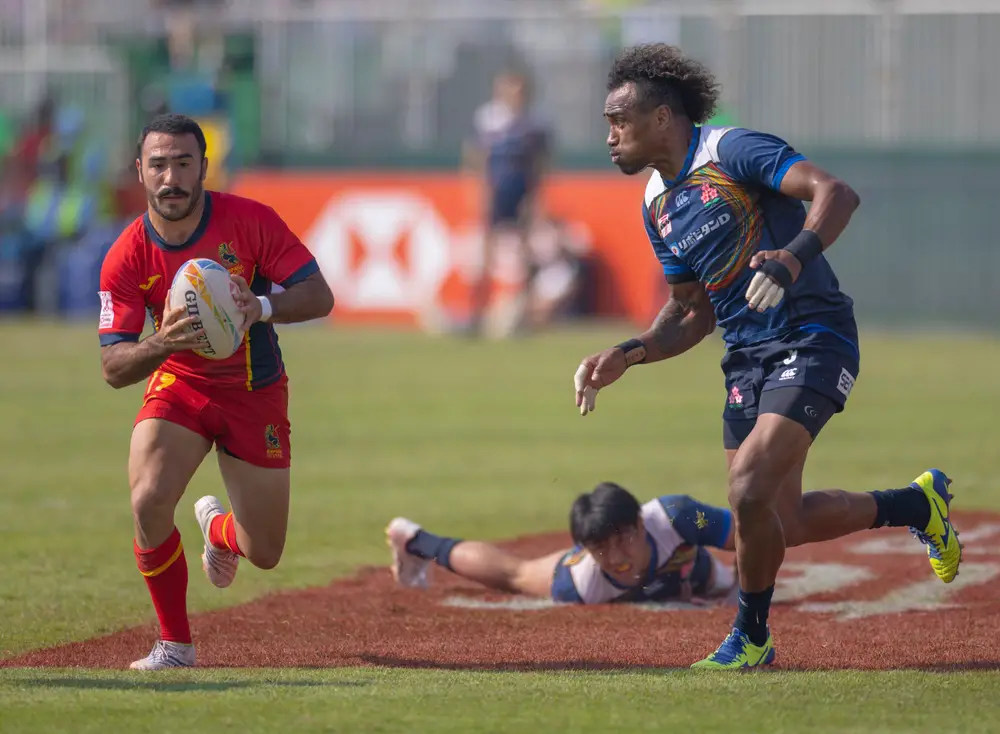Rugby sevens , also known as rugby sevens, is a sport derived from rugby union. Over the years, the sport has grown considerably and soon became an important event in international competitions, such as the Olympic Games.
The sport has gained notoriety for its fast pace, with matches usually lasting just 14 minutes. For this to work, however, you need to follow the rules of rugby sevens.
With that in mind, we’ve put together this special article with the main rules of rugby sevens so you can get to know the sport, whether you’re an aspiring player or just an enthusiast.
Check it out!
Open your Betano account and get up to 1,000 reais in bonuses.
PIX payments, live games and super odds! Click here to open your account!

Rugby sevens rules: complete list
- Place of play;
- Duration;
- Scoring;
- Players;
- Kick-off and drop-out;
- Scrum;
- Line-out;
- Infractions and penalties;
- Substitutions;
- In-goal zone;
- Refereeing.
Rugby sevens rules: playing venue
The rugby sevens pitch is identical to the traditional rugby union pitch, measuring approximately 100 meters long by 70 meters wide.
The lines of the field include the goal lines, the touch lines (sidelines), the 22-meter lines, the midfield line and the in-goal lines (scoring zone).
At the ends of each field are the goalposts, which form an “H” and are there for conversion kicks and penalty kicks to pass through.
Rugby sevens rules: duration
A rugby sevens match consists of two halves of seven minutes each, with a two-minute break between them.
However, in tournament finals, the time can be extended to two halves of ten minutes each. In the event of a draw, the game can go to extra time, and the first team to score points is declared the winner by sudden death.
Rugby sevens rules: scoring
Scoring in rugby sevens follows the same rules as rugby union, check them out:
- Try: worth 5 points when a player manages to put the ball on the ground in the opponent’s in-goal zone.
- Conversion: 2 points for the kick taken after a try, and must be taken from a line perpendicular to the point from which the try was scored.
- Penalty Kick: worth 3 points, this is a kick taken after an infringement by the opponent.
- Drop Goal: worth 3 points and is a kick made during the game, without the need for a restart.
Rugby sevens rules: players
Each team is made up of seven players on the pitch, which is why the sport bears that name, with up to five substitutes allowed. However, only three substitutions can be made during the game.
Rugby sevens rules: kick-off and drop-out
The game can be restarted in two ways, see below:
- Kick-off: the game starts with a kick-off from midfield, and the kicking team must ensure that the ball travels at least 10 meters.
- Drop-out from 22 meters: if the ball is kicked out over the end line by the attacking team, the game is restarted with a drop-out from the 22-meter line by the defending team.
Rugby sevens rules: scrum
In rugby sevens, the scrum is made up of three players from each team instead of eight, as in rugby union.
The scrum takes place to restart the game after minor infringements, such as a forward pass or a knock-on (when the ball is knocked forward).
Scrum formations are fast and possession disputes are intense due to the smaller number of players involved.
Rugby sevens rules: line-out
A line-out is used to restart play when the ball goes out along the sideline. Each team then lines up with two players, and the ball is thrown into the middle, with the players trying to gain possession by jumping and grabbing the ball.
Rugby sevens rules: infringements and penalties
The most common infractions in rugby sevens are: high tackle, interference, offside and knock-on. Penalties can result in a free kick, scrum or, in some cases, a yellow card, which leads to a two-minute temporary exclusion.
Infractions considered more serious can result in a red card, expelling the player from the rest of the match, which is complicated for the team’s reputation.
Conversions after a try and penalty kicks are important for adding extra points. In rugby sevens, conversions are made quickly, without the use of a tee, to maintain the pace of the game.
Rugby sevens rules: substitutions
Each rugby sevens team can make up to three substitutions during a match. Substitutions, then, need to be very strategic, allowing players to rest or the team to adjust its formation as necessary.
It’s worth noting that quick and effective substitutions can make a big difference to the outcome of the game!
Rugby sevens rules: in-goal zone
The in-goal zone is the area where tries are scored. So, the ball must touch the ground in this area for the try to be valid.
The defense has the task of preventing the attack from reaching the in-goal zone, while the attack tries to find gaps to score points.
Rugby sevens rules: refereeing
Referees play a crucial role in maintaining order and fairness in the game. There is a main referee and two assistants in rugby sevens, who monitor the game and ensure that the rules are followed.
Quick and accurate decisions are essential to keep the flow of the game constant and effective!

Rugby sevens rules: complete list
- Place of play;
- Duration;
- Scoring;
- Players;
- Kick-off and drop-out;
- Scrum;
- Line-out;
- Infractions and penalties;
- Substitutions;
- In-goal zone;
- Refereeing.
If you enjoyed learning about the rules of rugby sevens, take the opportunity to continue checking out our other articles on this and many other sports. Don’t forget to leave a comment too!



